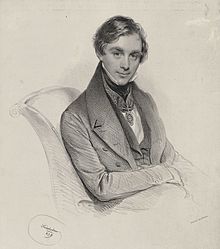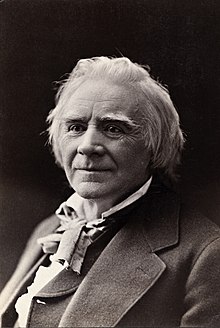Ole Bull

Ole Bornemann Bull (born February 5, 1810 in Bergen , † August 17, 1880 in Lysøen near Bergen) was a Norwegian violinist and composer .
Life
Bull came from an old and respected Norwegian family. The oldest verifiable ancestor of Bull was Pastor Jens Andersen Bull, who died in 1610. This was followed by three generations of pastors before the Bulls also emerged as merchants and officers. Ole Bull's grandfather Ole Bornemann Bull was a pharmacist in Bergen and married Gedsken Edvardine Storm, a sister of the Norwegian poet Edvard Storm . Their son Johan Storm Bull (1787–1838) was born in Copenhagen , but moved to Bergen with his parents as a child. He studied there and in Erfurt and then became a pharmacist in Bergen. He married Anna Dorothea Geelmuyden (1789–1875), who came from a respected Bergen family. The first of ten children of the couple was then the composer and violinist Ole Bull. At the age of nine years, Ole Bull violin solo played with the Bergen Orchestra Association harmonies . His teachers were Niels Eriksen and Johan Henrich Poulsen, later he was tutored by Carl Mathias Lundholm. His parents decided him to study theology, for which he did not pass the entrance exam. Instead, he founded a theater orchestra, which he led violin in hand. In 1829 he made appearances in Copenhagen and Kassel. After hearing Niccolò Paganini in Paris in 1831 , he imitated his manner, which quickly helped him to success despite his hitherto amateurish technique. Apart from the international concert scene, he continuously developed his technical level. In 1836/37 he gave 274 concerts in Ireland and England. In the following year he visited the great German violinist and composer Louis Spohr in the hope of making use of it as a violinist . In 1840 he played Beethoven's Kreutzer Sonata with Franz Liszt in London . In 1850 he founded the Norske Theater (Norwegian Theater) in Bergen , which later became the oldest Norwegian theater, Den Nationale Scene .
However, since his artistic breakthrough in Europe was temporarily denied, he set his hopes on five concert tours that he undertook through the USA. There he interpreted popular works, but also his own compositions on American themes. He gave these titles such as: Niagara , Solitude of the Prairie , In memory of G. Washington . He firmly believed that Norway needed to develop its own national art direction. Edvard Grieg , whose aunt was Ole Bull's sister-in-law, studied at the Leipzig Conservatory at his instigation .
With regard to the Norwegian musical tradition, Ole Bull is considered to be the great visionary of his time, in an attempt to disconnect from the then dominant Danish musical culture. He met Norwegian folk musicians early on. He drew inspiration from them and collected their songs and folk dances such as Springar , Gangar , Halling and Throndjemmer . Bull also inspired the poetry of the Norwegian poet Henrik Wergeland . Bull's aim was to make the rich cultural treasures of his country known and to make them heard by the Norwegian population. The basis of the Det Norske Theater In Bergen , which he founded in 1850, was supposed to be Norwegian plays, Norwegian actors, Norwegian music and Norwegian ballet, which was a novelty in the country at the time. In 1849 Bull supported the fiddler Torgeir Augundsson from Telemark , who was thus able to give a concert in Christiana , where he was the first musician to publicly present local Norwegian folk music to the upper class on his Hardanger fiddle .
Many of his smaller works are of a sentimental character and have names like
- A mother's prayer
- A visit to the pasture (Et Sæterbesøg),
- Dairy Girl's Sunday (Sæterjentens søndag),
- A mountain vision
- In lonely hour (I ensomme hour)
- Adagio religioso,
- La Mélancolie,
- Pollaca guerriera,
- Recuerdos de Habana
In addition, Bull also composed in large formats such as two concertos for violin and orchestra or theme and fantasy on a theme by Vincenzo Bellini . The violin concertos were not rediscovered until after 2000; In 2008 the world premiere was recorded on sound carriers (SACD and Blu-ray Audio; Annar Follesö (violin), Norwegian Radio Orchestra, Ole Kristian Ruud (conductor)).
Attracted by the ideas of communal socialism that were emerging at the time, Bull bought around 3,000 acres of land in Pennsylvania to realize his ideas there. He named the area "Oleana". Because of his lack of business acumen, this company failed after less than two years. The area is now known as Ole Bull State Park . Henrik Ibsen ironicized Bull's experiment in his drama Peer Gynt , in which the eponymous hero founds a short-lived state of Gyntiana .
Bull is today (also because of his social attitude) one of the great national and cosmopolitan personalities of Norway. He died in 1880 of cancer on the island of Lysø, which belongs to him and was designed according to romantic ideals, in the municipality of Os (Hordaland) . His house, "the little Alhambra" in the Arab-Moorish style, combined with the Norwegian lafting style and the Russian-felt dome tower, is now a museum.
His violin, attributed to Gasparo da Salò , which is decorated with splendid inlays and carvings, is now in a showcase at the Vestlandske Art Industry Museum in Bull's hometown of Bergen.
In many places in Norway, streets and squares are named after Ole Bull. Bullgasse in Vienna-Favoriten has been named after him since 1955 .
Discography
- “Arve Tellefsen plays Ole Bull” (Simax 2004/2009): Nocturne for violin & orchestra; A Mountain Vision; Mother's Prayer from “Polacca Guerriera”; Adagio Sostenuto from the Violin Concerto in E minor; Gran March from “Agiaco Cubano”; Cantabile dolorose & Rondo Giocoso + The herdgirl's Sunday for violin & string ensemble; In Moments of Solitude for violin & string ensemble + works for violin & piano: Andante maestoso from “Agiaco Cubano”; Sigrid's song from "The Mountain Cottage"; Barcarolle; Scotch fantasy; Andante cantabile; Cantabile; In Moments of Solitude
Individual evidence
- ↑ Einar Haugen, Einar Ingvald Haugen and Camilla Cai: Ole Bull - Norway's Romantic Musician and Cosmopolitan Patriot , University of Wisconsin Press, 1993, p. 5
- ↑ Hartmut Becker: Louis Spohr - The Violin Concertos. Plate text for cpo 999 403-2 (Louis Spohr - Violin Concertos 1, 14 & 15)
- ↑ Peter Brandt, Werner Daum and Miriam Horn: The Scandinavian Way into Modernity - Contributions to the History of Norway and Sweden from the Late Middle Ages to the 20th Century , Berliner Wissenschafts-Verlag, 2016, p. 222
- ^ Bjorn Aksdal: The Norwegian Hardanger Fiddle in Classical Music , p. 16
- ↑ jpc.de: [1]
- ↑ Horst Schwartz: The unknown national hero. Hardly anyone in this country knows him, but in Norway the violinist and composer Ole Bull enjoys great respect. In: Neues Deutschland from 1./2. September 2018, p. 30
- ↑ [2] Anniversary site Ole Bull 2010 of the art museums in Bergen (English)
- ↑ www.simax.no ( Memento of the original from April 27, 2015 in the Internet Archive ) Info: The archive link was inserted automatically and has not yet been checked. Please check the original and archive link according to the instructions and then remove this notice. (Simax is a Norwegian classic label)
Web links
- Literature by and about Ole Bull in the catalog of the German National Library
- Sheet music and audio files by Ole Bull in the International Music Score Library Project
- Ole Bull: Digital collection on the Ole Bull 2010 anniversary site of the art museums in Bergen
| personal data | |
|---|---|
| SURNAME | Bull, Ole |
| ALTERNATIVE NAMES | Bull, Ole Bornemann (full name) |
| BRIEF DESCRIPTION | Norwegian violinist and Romantic composer |
| DATE OF BIRTH | February 5, 1810 |
| PLACE OF BIRTH | Bergen (Norway) |
| DATE OF DEATH | 17th August 1880 |
| Place of death | Bergen (Norway) |
